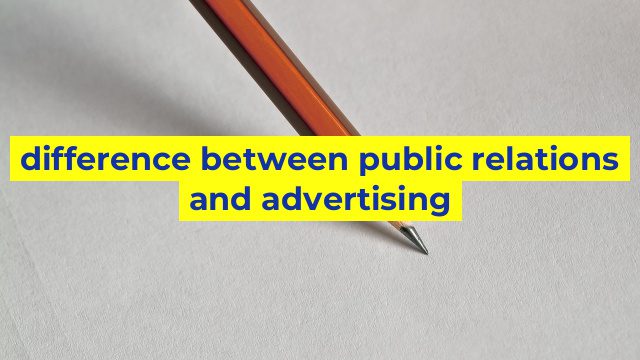The Basic Differences Between Public Relations and Advertising
Both public relations (PR) and advertising play important roles in the promotion and marketing of businesses, products, and services. However, there are key differences between the two. Understanding these differences can help you choose which one is more appropriate for your specific marketing requirements.
Definition of Public Relations and Advertising
Public relations (PR) is the art and science of building relationships between a brand and its target audience. This involves creating and maintaining a favorable image and reputation for the brand through various communication channels, such as media relations, social media, and events.
Advertising, on the other hand, refers to the paid promotion of a product, service, or company using various media platforms, such as TV, radio, print ads, and online banners. It is aimed at persuading and convincing consumers to purchase a particular product or service.
Control Over the Message
One of the key differences between PR and advertising is the level of control over the message conveyed to the target audience. In advertising, companies have complete control over the message, its placement, and its frequency of exposure. Advertisements are carefully crafted to convey the desired message and evoke specific emotions.
In contrast, PR involves building a relationship with journalists, influencers, and other members of the media to secure positive publicity. The message conveyed through PR activities is largely dependent on the perception and interpretation of the media outlets and their audience.
Credibility
Consumers are becoming increasingly resistant to traditional advertising, and with the rise of ad-blockers, many people simply ignore ads. As a result, the credibility of advertising is often questioned, as consumers view ads as self-promotion.
On the other hand, PR activities often result in earned media coverage, which is considered more credible since a third-party, such as a respected journalist, is vouching for the brand.
Cost
Advertising is a significant expense for businesses. Creating a compelling ad campaign and buying media space can cost thousands or even millions of dollars, depending on the medium used and the campaign’s reach.
In contrast, while PR may require a budget to cover agency or consultant fees, many PR activities, such as publicity stunts, product demonstrations, and media events, can be done without incurring significant expenses.
Conclusion
In summary, while both PR and advertising are essential marketing strategies, they differ significantly in their approach, control over messaging, credibility, and cost-effectiveness. When deciding which approach is best for your business, consider your desired outcome, target audience, budget, and resources available. By properly assessing your options, you can create a successful marketing campaign that meets your business objectives.
Table difference between public relations and advertising
| Public Relations | Advertising |
|---|---|
| Focuses on building relationships and reputation through media coverage, events, and community outreach. | Focuses on paid promotions through various mediums such as print, online, radio, or television. |
| Does not control the message or medium, but instead relies on media outlets to share their message. | Has complete control over the message and the medium in which it is shared. |
| Goal is to maintain a positive reputation and public perception of the organization or individual they represent. | Goal is to drive sales or create immediate responses from the target audience. |
| Focuses on long-term, sustainable relationships and reputation building. | Focuses on short-term, immediate results and conversions. |
| Uses a variety of tools, such as press releases, media pitches, interviews, and social media campaigns to build and maintain relationships. | Uses a variety of tools, such as print and digital ads, commercials, sponsored content, and social media advertising to drive sales or create responses. |


